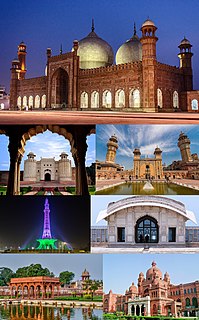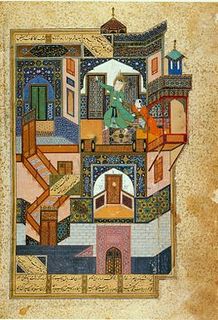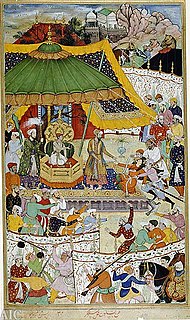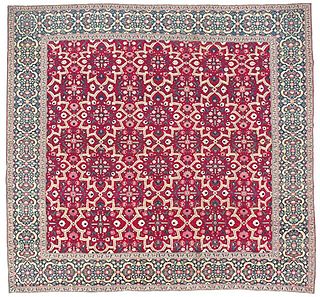Related Research Articles

Lahore is the capital of the Pakistani province of Punjab and is the country's 2nd largest city after Karachi, as well as the 26th largest city in the world. Lahore is one of Pakistan's wealthiest cities with an estimated GDP (PPP) of $84 billion as of 2019. It is the largest city and historic cultural centre of the wider Punjab region, and is one of Pakistan's most socially liberal, progressive, and cosmopolitan cities.

about the concept of visual arts in art history|the architecture associated

Islamic architecture comprises the architectural styles of buildings associated with Islam. It encompasses both secular and religious styles from the early history of Islam to the present day. Islamic architecture developed to fulfill Islamic religious ideals, for example, the minaret was designed to assist the muezzin in making his voice heard throughout a specific area.

The Lahore Fort is a citadel in the city of Lahore, Punjab, Pakistan. The fortress is located at the northern end of walled city Lahore, and spreads over an area greater than 20 hectares. It contains 21 notable monuments, some of which date to the era of Emperor Akbar. The Lahore Fort is notable for having been almost entirely rebuilt in the 17th century, when the Mughal Empire was at the height of its splendour and opulence.

Mughal painting is a particular style of South Asian, particularly North Indian, painting confined to miniatures either as book illustrations or as single works to be kept in albums (muraqqa). It emerged from Persian miniature painting and developed in the court of the Mughal Empire of the 16th to 18th centuries. The Mughal emperors were Muslims and they are credited with consolidating Islam in South Asia, and spreading Muslim arts and culture as well as the faith.

A Persian miniature is a small Persian painting on paper, whether a book illustration or a separate work of art intended to be kept in an album of such works called a muraqqa. The techniques are broadly comparable to the Western Medieval and Byzantine traditions of miniatures in illuminated manuscripts. Although there is an equally well-established Persian tradition of wall-painting, the survival rate and state of preservation of miniatures is better, and miniatures are much the best-known form of Persian painting in the West, and many of the most important examples are in Western, or Turkish, museums. Miniature painting became a significant genre in Persian art in the 13th century, receiving Chinese influence after the Mongol conquests, and the highest point in the tradition was reached in the 15th and 16th centuries. The tradition continued, under some Western influence, after this, and has many modern exponents. The Persian miniature was the dominant influence on other Islamic miniature traditions, principally the Ottoman miniature in Turkey, and the Mughal miniature in the Indian sub-continent.

Abdur Rahman Chughtai was a painter artist and intellectual from Pakistan, who created his own unique, distinctive painting style influenced by Mughal art, miniature painting, Art Nouveau and Islamic art traditions. He is considered to be 'the first significant modern Muslim artist from Pakistan', and the national artist of Pakistan.

Hagop Kevorkian was an Armenian-American archeologist, connoisseur of art, and collector, originally from Kayseri, who graduated from the American Robert College in Istanbul, settled in New York City in the late 19th century, and helped America acquire a taste for Eastern artifacts.

Farrukh Beg, also known as Farrukh Husayn, was a Persian miniature painter, who spent a bulk of his career in Safavid Iran and Mughal India, praised by Mughal Emperor Jahangir as “unrivaled in the age.”

'Abd al-Samad or Khwaja Abdus Samad was a 16th-century painter of Persian miniatures who moved to India and became one of the founding masters of the Mughal miniature tradition, and later the holder of a number of senior administrative roles. Samad's career under the Mughals, from about 1550 to 1595, is relatively well documented, and a number of paintings are attributed to him from this period. From about 1572 he headed the imperial workshop of the Emperor Akbar and "it was under his guidance that Mughal style came to maturity". It has recently been contended by a leading specialist, Barbara Brend, that Samad is the same person as Mirza Ali, a Persian artist whose documented career seems to end at the same time as Abd al-Samad appears working for the Mughals.

A Muraqqa is an album in book form containing Islamic miniature paintings and specimens of Islamic calligraphy, normally from several different sources, and perhaps other matter. The album was popular among collectors in the Islamic world, and by the later 16th century became the predominant format for miniature painting in the Persian Safavid, Mughal and Ottoman empires, greatly affecting the direction taken by the painting traditions of the Persian miniature, Ottoman miniature and Mughal miniature. The album largely replaced the full-scale illustrated manuscript of classics of Persian poetry, which had been the typical vehicle for the finest miniature painters up to that time. The great cost and delay of commissioning a top-quality example of such a work essentially restricted them to the ruler and a handful of other great figures, who usually had to maintain a whole workshop of calligraphers, artists and other craftsmen, with a librarian to manage the whole process.

Basāwan, or Basāvan, was an Indian miniature painter in the Mughal style. He was known by his contemporaries as a skilled colorist and keen observer of human nature, and for his use of portraiture in the illustrations of Akbarnama, Mughal Emperor, Akbar's official Biography, which is seen as an innovation in Indian art.
A Pakistani rug or Pakistani carpet is a type of handmade floor-covering textile traditionally made in Pakistan.

The Badshahi Mosque is a Mughal-era congregational mosque in Lahore, capital of the Pakistani province of Punjab, Pakistan. The mosque is located west of Lahore Fort along the outskirts of the Walled City of Lahore, and is widely considered to be one of Lahore's most iconic landmarks.
Hermann Goetz was a German art historian and museum director, known for his scholarly contributions in the field of Indian art history. He was the Director of the Baroda Museum & Picture Gallery, and the Director of history of art at the Heidelberg University's Südasien-Institut.

The Shrine of Khalid Walid is a Sufi shrine located in the village of Nawan Shehr, near the Pakistani city of Kabirwala. The shrine is dedicated to the 12th century warrior-saint Khaliq Walid, popularly known instead as Khalid Walid. The shrine dates from the period of the medieval Delhi Sultanate, and may be the earliest Muslim funerary monument in South Asia. The shrine represents the first stage of evolution of funerary monuments in southern Punjab which would later culminate with the Tomb of Shah Rukn-e-Alam in Multan.

Turkeywork is a knotted-and-cut pile furnishing textile produced in England from the sixteenth to the mid-eighteenth centuries. Turkeywork was used for table carpets, cupboard carpets, cushions, and especially for matched sets of upholstery for chair seats and backs.

Mughal karkhanas were the manufacturing houses and workshops for craftsmen, established by the Mughals in their empire. Karkhana is a Hindustani language word that means factory. These karkhanas were small manufacturing units for various arts and crafts as well as for the emperor's household and military needs. karkhanas were named and classified based on the nature of the job. For example, 'Rangkhana' and 'Chhapakhana' were for textile dyeing and printing work. The term 'tushak-khana' was used to describe workshops that made shawls and embellished them with embroidery or needlework. Imperial or Royal Karkhanas were for luxury goods and weapons. The karkhanas were the place for various production activities and also for the exploration of new techniques and innovations. Some operations such as weaving, embroidery work, and brocade work were often done under one roof, resembling an integrated assembly line.

Mughal carpets were the handwoven floor coverings used in the Mughal Empire in their courts. Mughal carpets and rugs have their roots in India since the 16th and 17th centuries. Mughal carpets were a blend of Persian and Indian artistry uniquely designed with scenic landscapes, floral, and animal patterns. Kashmir was producing the finest wool and silk carpets and rugs, including prayer rugs. Sometimes the knot density in these rugs was so fine and tight as 300 knots per square centimeter.
Mahmud the Kurd was a 15th-century Kurdish artist, craftsman and designer of the late medieval era.
References
- ↑ Bell, James Elton; Bell, Frances Jean (2007). Sir Robert Bell and His Early Virginia Colony Descendants: A Compilation of 16th, 17th, and 18th Century English and Scottish Families with the Surname Bell, Beale, Le Bel ... Et Al. Wheatmark, Inc. p. 95. ISBN 978-1-58736-747-2.
- ↑ Bloom, Jonathan; Blair, Sheila S.; Blair, Sheila (2009-05-14). Grove Encyclopedia of Islamic Art & Architecture: Three-Volume Set. OUP USA. p. 368. ISBN 978-0-19-530991-1.
- ↑ "Mughal carpet". Encyclopedia Britannica. Retrieved 2021-01-04.
- ↑ Walker, Daniel S.; N.Y.), Metropolitan Museum of Art (New York (1997). Flowers Underfoot: Indian Carpets of the Mughal Era. Metropolitan Museum of Art. p. 166. ISBN 978-0-87099-788-4.
- ↑ Irwin, John (1962). The Girdlers' Carpet. order of the Court of Girdlers Company.